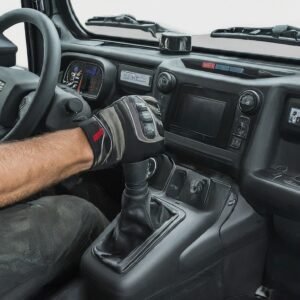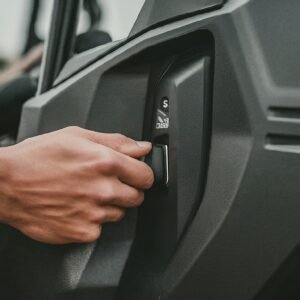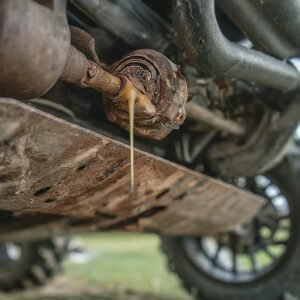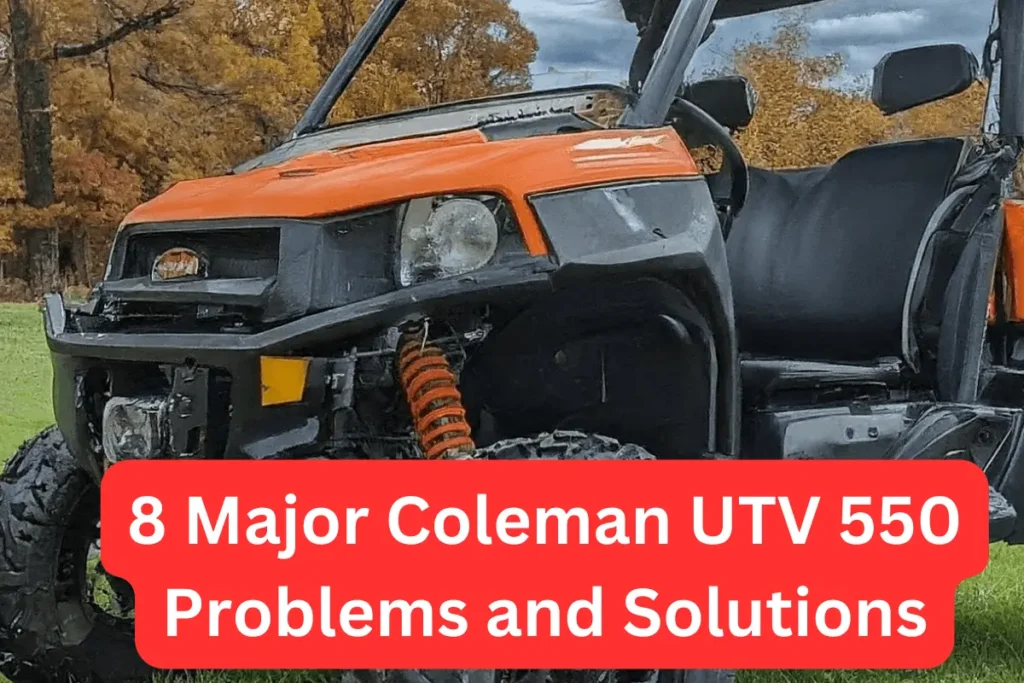Are you facing issues with your Honda Pioneer 520? You are not alone because most owners also face problems with it.
The most common Honda Pioneer 520 problems are shifting issues, difficulty starting, heat in the cab or under the seat, oil leak issues, transmission problems, tire issues, jolting rides, and electrical issues.
So here we discuss them in detail with their easy solutions and you see most of the issues are the same as of issues with the Honda Pioneer 500.
Honda Pioneer 520 Problems and Solutions
Now we are going to discuss the major problems of Honda Pioneer UTV with their easy solutions.
1. Honda Pioneer 520 shifting problems

- Difficulty Shifting Gears: If you’re having trouble shifting gears, it could be due to issues with the transmission linkage or clutch system. Inspect the linkage for any signs of damage or misalignment, and adjust or replace it as needed. Additionally, check the clutch system for proper adjustment and wear, and consider replacing any worn components to restore smooth shifting.
- Grinding or Clunking Noise: Unusual grinding or clunking noises when shifting gears may indicate problems with the transmission or gear mechanism. Check the transmission fluid level and condition, as low or contaminated fluid can cause shifting difficulties. If the fluid is dirty or low, flush and refill it according to the manufacturer’s recommendations.
- Stuck in Gear: If your Pioneer 520 is stuck in gear and won’t shift, it could be due to a malfunctioning shift cable or linkage. Inspect the shift cable for any signs of damage or binding, and replace it if necessary. Additionally, check the shift linkage for proper adjustment and lubrication, as lack of lubrication can cause sticking or binding.
- Slipping Gears: Gears slipping or jumping out of gear while driving can be a safety hazard and indicate serious transmission problems. Check the transmission fluid level and condition, as low or contaminated fluid can cause gear slippage. If the fluid is clean and at the correct level, the issue may be internal to the transmission and require professional diagnosis and repair.
- Difficulty Engaging or Disengaging Differential Lock: If you’re having trouble engaging or disengaging the differential lock, it could be due to issues with the differential mechanism or linkage. Inspect the differential components for any signs of damage or wear, and lubricate or replace them as needed. Additionally, ensure that the differential lock switch or lever is functioning correctly and adjusted properly.
2. Difficult to start

- Check the Battery: A weak or dead battery is a common reason for starting problems. Make sure the battery terminals are securely connected and clean. If the battery is old or not holding a charge, it may need to be replaced.
- Inspect the Fuel System: Make sure that there’s enough fuel in the tank and that the fuel is clean and free from contaminants. If the fuel is old or stale, drain the tank and refill it with fresh fuel. Additionally, check the fuel filter and fuel lines for any blockages or damage.
- Verify the Ignition System: Check the ignition switch and key to ensure they’re functioning correctly. If the key is worn or damaged, it may not engage the ignition properly. Also, inspect the spark plug to see if it’s fouled or worn out and replace it if necessary.
- Examine the Engine: Inspect the engine for any signs of damage or wear, such as loose wires, damaged hoses, or leaking fluids. Address any issues found during the inspection to ensure the engine is operating properly.
- Test the Starter Motor: If the engine fails to turn over when you attempt to start it, the starter motor may be faulty. Test the starter motor by tapping it lightly with a hammer while someone else attempts to start the engine. If the engine starts, the starter motor may need to be replaced.
- Check the Carburetor: If your Honda Pioneer 520 has a carburetor, check it for any clogs or blockages that may be preventing fuel from reaching the engine. Clean the carburetor thoroughly or have it professionally serviced if necessary.
- Review the Owner’s Manual: Refer to the owner’s manual for your Honda Pioneer 520 for specific troubleshooting steps and maintenance procedures recommended by the manufacturer.
- Seek Professional Help: If you’re unable to diagnose or resolve the starting issue on your own, consider taking your Honda Pioneer 520 to a certified mechanic or authorized Honda dealership for professional inspection and repair.
Also explore the top speed of the Honda Pioneer 520
3. Heat in the cab and under seat issues
- Cabin Heat: Heat buildup in the cab can make for an uncomfortable ride, especially during hot weather or extended periods of use. One common cause is inadequate ventilation, which can trap heat inside the cabin. Consider installing additional vents or fans to improve airflow and dissipate heat more effectively. You can also use sunshades or tinted windows to reduce the amount of sunlight entering the cabin, thereby lowering temperatures.
- Under Seat Heat: Heat under the seat can be caused by various factors, such as engine heat transfer, exhaust system proximity, or inadequate insulation. Inspect the area under the seat to identify any sources of heat, such as exhaust pipes or engine components, and take measures to shield or insulate them. Additionally, consider installing heat shields or thermal barriers to prevent heat transfer to the seat area.
- Cooling Systems: Ensure that your Honda Pioneer 520’s cooling systems, such as the radiator and cooling fan, are functioning correctly. Overheating engine components can contribute to increased heat in the cab and under the seat. Regular maintenance, including checking coolant levels and inspecting cooling system components for any signs of damage or malfunction, can help prevent overheating issues.
- Seating Material: The type of material used in the seats can also affect heat retention. If your seats are made of materials that tend to trap heat, such as vinyl or leather, consider installing seat covers or cushions made of breathable and heat-resistant materials. This can help reduce heat buildup and improve overall comfort during rides.
- Insulation and Heat Shielding: Adding insulation materials or heat shields to the cabin and under-seat areas can help reduce heat transfer and improve comfort. Consider using materials such as foam insulation or thermal barrier blankets to insulate the cabin and protect sensitive components from heat exposure.
4. Oil Leaks issues

- Identifying the Leak: The first step is to identify the source of the oil leak. Check underneath your vehicle for any signs of oil puddles or drips. Inspect the engine, transmission, and differential areas for any visible leaks or wet spots.
- Inspecting Gaskets and Seals: Oil leaks often occur due to worn or damaged gaskets and seals. Inspect the gaskets and seals around the engine, oil filter, drain plug, and other components for signs of wear, cracks, or deterioration.
- Checking Oil Levels: Monitor your Honda Pioneer 520’s oil levels regularly to verify that they are within the recommended range. Low oil levels can indicate a leak or another issue that needs to be addressed promptly.
- Tightening Loose Bolts and Fasteners: Sometimes, oil leaks can occur due to loose bolts or fasteners. Check for any loose bolts or fittings around the engine and tighten them as needed to prevent leaks.
- Replacing Faulty Components: If you identify any damaged gaskets, seals, or other components contributing to the oil leak, it’s essential to replace them promptly. Consult your owner’s manual or a certified mechanic for guidance on proper replacement procedures.
- Regular Maintenance: Performing regular maintenance, such as oil changes and inspections, can help prevent oil leaks and prolong the life of your Honda Pioneer 520. Follow the manufacturer’s recommended maintenance schedule to keep your vehicle in top condition.
5. Transmission Problems
- Gear Slipping or Shifting Difficulty: One of the most common transmission problems is gear slipping or difficulty in shifting gears. This can occur due to worn-out clutch plates or improper adjustment of the clutch cable. To resolve this issue, it’s essential to inspect the clutch system thoroughly and replace any damaged or worn components. Additionally, adjusting the clutch cable to the manufacturer’s specifications can help ensure smooth gear shifting.
- Strange Noises or Grinding Sensation: If you notice unusual noises such as grinding or clunking when shifting gears, it could indicate a problem with the transmission gears or bearings. This may be caused by worn-out gears, damaged bearings, or low transmission fluid levels. To address this issue, it’s important to check the transmission fluid level and condition and top it up or replace it if necessary. If the problem persists, consulting a professional mechanic for further diagnosis and repair is recommended.
- Delayed Engagement or Loss of Power: Delayed engagement or a loss of power while accelerating can be signs of transmission issues such as slipping clutches or worn-out transmission components. In some cases, this may be due to a malfunctioning transmission control module (TCM) or sensor. It’s essential to have the vehicle inspected by a qualified technician to diagnose the underlying cause accurately. Depending on the severity of the issue, repairs may involve replacing worn-out components or recalibrating the TCM.
- Fluid Leaks: Transmission fluid leaks are another common problem that can affect the performance of your Honda Pioneer 520’s transmission. Leaks can occur due to damaged seals, gaskets, or transmission pan bolts. It’s important to inspect the transmission system regularly for any signs of fluid leakage and repair any leaks promptly to prevent damage to the transmission components. Additionally, maintaining the correct transmission fluid level is crucial for optimal performance and longevity of the transmission.
- Overheating: Overheating of the transmission can lead to various issues such as fluid breakdown, loss of lubrication, and damage to internal components. Common causes of transmission overheating include towing heavy loads, driving in extreme temperatures, or a malfunctioning transmission cooler. To prevent overheating, it’s essential to avoid excessive towing and maintain the transmission cooler system regularly. Installing an auxiliary transmission cooler can also help dissipate excess heat and prolong the life of the transmission.
6. Tire issues
- Tire Wear: One of the most common issues with tires is wear and tear. Over time, the tread on your tires can become worn down, affecting traction and handling. Regularly inspect your tires for signs of wear, such as uneven tread wear or bald spots. If you notice significant wear, it’s time to replace your tires to maintain optimal performance and safety.
- Tire Punctures: Punctures can occur due to nails, screws, or other sharp objects on the road. If you notice a puncture in your tire, it’s essential to address it promptly to prevent further damage and potential blowouts. Consider carrying a tire repair kit with you for quick fixes on the go, or visit a professional tire repair shop for expert assistance.
- Tire Pressure: Incorrect tire pressure can lead to a host of issues, including reduced fuel efficiency, poor handling, and increased risk of blowouts. Regularly check your tire pressure using a tire pressure gauge and ensure that it matches the recommended pressure specified in your vehicle’s owner’s manual. Adjust the pressure as needed to maintain optimal performance and safety.
- Tire Alignment: Misaligned tires can cause uneven tire wear and affect the handling and stability of your vehicle. If you notice your Honda Pioneer 520 pulling to one side or experiencing vibrations while driving, it may be a sign of misalignment. Visit a professional mechanic to have your tires properly aligned to prevent further damage and ensure a smooth ride.
- Tire Rotations: Regular tire rotations are essential for maintaining even tread wear and extending the lifespan of your tires. Consider rotating your tires according to the recommended schedule outlined in your vehicle’s owner’s manual or during routine maintenance visits. This helps ensure that your tires wear evenly and perform optimally for longer.
- Choosing the Right Tires: When replacing your tires, it’s crucial to choose the right type and size for your Honda Pioneer 520. Consider factors such as terrain, weather conditions, and intended use when selecting tires. Consult with a tire specialist or refer to your owner’s manual for recommendations on the best tires for your vehicle.
7. Jolting ride
- Suspension Adjustment: The jolting sensation could be due to the suspension settings not being optimized for offroad terrain. Check your owner’s manual for guidance on adjusting the suspension to better absorb bumps and shocks.
- Tire Pressure: Incorrect tire pressure can also contribute to a rough ride. Make sure your tires are inflated to the recommended pressure for off-road driving. Lowering the tire pressure slightly can help improve traction and cushion the ride over uneven terrain.
- Terrain Selection: The terrain you’re driving on may be too rough for the suspension to handle comfortably. Try to choose smoother paths or adjust your driving technique to navigate rough terrain more smoothly.
- Maintenance: Regular maintenance of your Honda Pioneer 520 is essential for optimal performance. Check for any worn or damaged suspension components and replace them as needed. Lubricate moving parts to ensure they operate smoothly.
- Driving Technique: Your driving technique can also affect the ride quality. Try to maintain a steady speed and avoid sudden movements or aggressive maneuvers that could cause the vehicle to bounce or jolt.
- Aftermarket Upgrades: Consider investing in aftermarket suspension upgrades or accessories designed to improve offroad performance. Upgrading to high-quality shocks or adding additional suspension components can help smooth out the ride and enhance overall handling.
8. Electrical issues
If you’re facing electrical issues with your Honda Pioneer 520, it’s essential to address them promptly to ensure your vehicle’s safety and performance. Here’s a helpful guide to understanding and troubleshooting common electrical problems:
- Battery Problems: If your Pioneer 520 won’t start or experiences intermittent power loss, the battery could be the culprit. Check the battery terminals for corrosion or loose connections. Clean the terminals and tighten any loose connections to ensure a secure electrical connection.
- Faulty Wiring: Electrical issues can also stem from faulty wiring or damaged electrical components. Inspect the wiring harness and connectors for signs of wear, corrosion, or damage. Replace any damaged wires or connectors to restore proper electrical function.
- Fuse Issues: Blown fuses can cause various electrical problems in your Pioneer 520. Check the fuse box for any blown fuses and replace them with the appropriate amperage rating. Be sure to diagnose and address the underlying cause of the fuse failure to prevent future issues.
- Starter Motor Problems: If your Pioneer 520 struggles to start or makes clicking sounds when you turn the key, the starter motor may be malfunctioning. Test the starter motor and solenoid for proper operation and replace them if necessary.
- Charging System Malfunction: A malfunctioning charging system can lead to a dead battery and electrical issues. Test the alternator output voltage to ensure it’s within the manufacturer’s specifications. Replace the alternator if it’s not charging the battery properly.
- Electrical Component Failure: Individual electrical components, such as switches, relays, or sensors, can fail over time, causing various electrical problems. Test each component for proper operation and replace any faulty ones to restore electrical function.
- Grounding Issues: Poor grounding can result in electrical issues, including intermittent power loss and electrical shorts. Check the ground connections for corrosion or looseness and ensure they’re securely connected to the chassis or engine block.
- Voltage Regulator Problems: A faulty voltage regulator can cause overcharging or undercharging of the electrical system, leading to battery issues and electrical malfunctions. Test the voltage regulator for proper operation and replace it if necessary.
- Ignition Switch Failure: A faulty ignition switch can prevent your Pioneer 520 from starting or cause intermittent electrical problems. Test the ignition switch for continuity and replace it if it’s faulty.
Conclusion:
As you see here we discuss the major Honda Pioneer 520 problems with their easy solution. So whenever you encounter any of these problems you can solve it easily by following our guide.

